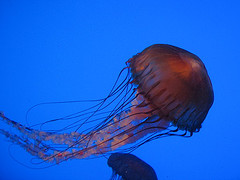 Over Thanksgiving, I came across a news story that may represent the perfect storm of issues plaguing the oceans. A salmon farm in Northern Ireland was wiped out by a huge swarm of mauve stingers (Pelagia noctiluca), a jelly usually found in the warm Mediterranean sea.
Over Thanksgiving, I came across a news story that may represent the perfect storm of issues plaguing the oceans. A salmon farm in Northern Ireland was wiped out by a huge swarm of mauve stingers (Pelagia noctiluca), a jelly usually found in the warm Mediterranean sea.
In a 35-foot-deep, 10-square-mile swath, the jellies stung and killed 100,000 salmon before workers could reach the pens. It must have been quite a sight. The jelly’s scientific name means “light of the sea,” and the creatures give off an eerie, purple-red glow. I can only imagine that, at that scale, the sea looked possessed.
The incident may seem strange and isolated, but it touches on three major issues facing the oceans.
First, global warming. As temperatures rise, creatures that were once found in warm waters closer to the equator can migrate north, creating unprecedented meetings between species like the jellies and the salmon. Likewise, cold-water creatures are forced farther north in search of an appropriate home.
Second, overfishing. Oceana’s research vessel, Ranger, spends summers in the Mediterranean documenting the effects of taking too many fish out of the sea. This year, Ranger photographed mauve stinger swarms in places where they shouldn’t be, like Spain’s rich coast. Jellies thrive when there are no predators present to keep their populations in check. In the Mediterranean, overfishing has depleted carnivorous fish, leading to an ecosystem that’s out of balance. Only in these circumstances could such a large swarm of jellies assemble.
Lastly, fish farming. Farmed salmon are almost all fed on pelleted wild fish. The fish pellets are flung into the pens via sprinkler-like automatic feeders, and much of them sink to the bottom uneaten — along with thousands of pounds of fish waste. Depending on which study you read, it can take two to ten pounds of wild fish to raise one pound of farmed salmon. Meanwhile, demand for farmed salmon — and the wild fish to feed them — grows and grows. According to a May 2007 Infofish report, farmed salmon production increased by 21 percent between 2001 and 2004. The fish farm destroyed last week was Northern Ireland’s first salmon farm, and it probably won’t be the country’s last.
It’s a lot to take in just from one simple, seemingly freakish news story. And just yesterday, the Wall Street Journal reported on alarming jelly swarms in Japan ($ub. req’d). It doesn’t seem so freakish, however, when you know about the mechanisms behind the moment.
 Over Thanksgiving, I came across a
Over Thanksgiving, I came across a 
